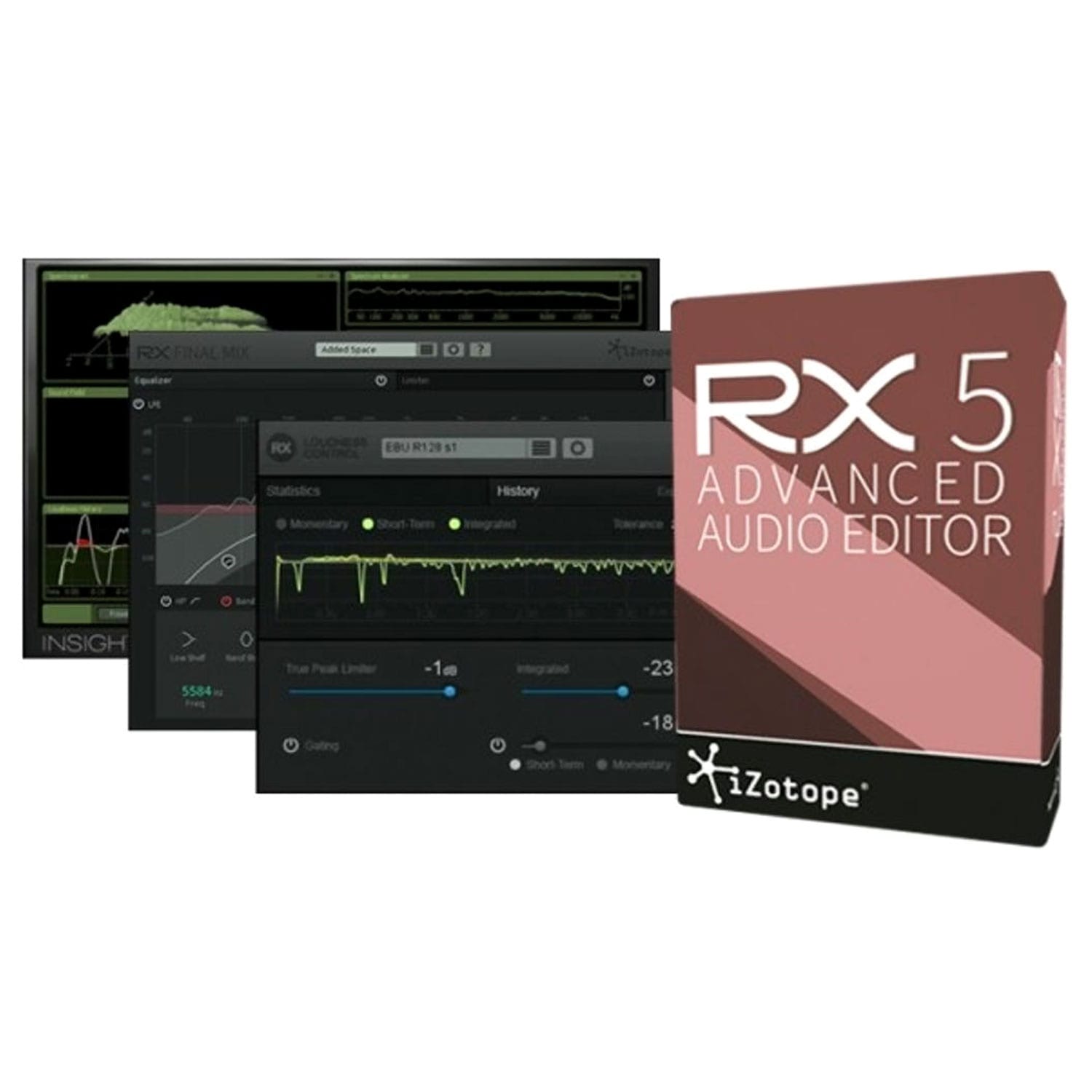Tutorial on Commonly Used Modules
It’s no surprise, therefore, that iZotope’s RX 5 Audio Editor has come to define itself as one of the leading choices for audio restoration and post production. As well as the usual ‘corrective’ tasks – such as noise removal, click suppression and so on – RX has proved itself to be a boon across a range of production activities.
This is our 3rd article on iZotope’s audio repair tool RX 7.
We will continue to look at editing using different modules.
Though many modules are included, I have chosen a few which I find personally useful and common to take a look at.
iZotope RX 7 Tutorial ③ – Video Access

Purchase here
De-hum
First take a listen to this sample.
https://sleepfreaks-dtm.com/wordpress/wp-content/uploads/2020/03/Hum_Crackle_pre.mp3
We can hear a low humming noise as well as a constant crackling sound as well.
Lets try to get rid of these.
We will be using De-hum to remove the hum noise.
Hum noise is usually based around low frequencies in the 50-60Hz range, and is a noise that contains a number of harmonics.
We could select 50 or 60Hz from Base Frequency, but if you want AI to make the choice for you, click the Suggest button at the top.
This will analyse the sample and Free mode will allow it to set a more accurate frequency.
The hum noise can been reduced greatly but if the voice has been negatively effected as well, we can lower the number of harmonics down right on the brink of effecting the main sound. We can do this from the Number of harmonics fader.
Next lets adjust the amount of cut. You can make changes from the screen, but the frequency points can get shifted in free mode so we’ll enter numerical changes below.
Find a point where the noise isn’t noticeable yet the vocal remains clean.
For the low end, you can cut up until the point where it starts effecting the vocal. We will turn the High-Pass Filter on and cut under 100Hz.
Izotope Rx 2 Free Download
Though you most likely won’t be using the Low-pass-filter, it may be necessary depending on the type of noise present.
If we want to make more detailed edits on the harmonics we can choose a different Linking Type.
For the default ALL setting, moving the slider here will have a slope effect on all frequencies.
By selecting Odd/even you can control the odd and even harmonics separately.
The Slope slider will help lower the reduction effect on higher frequencies.
When None is selected the link is removed, allowing you to control the Gain of individual harmonics.
De-Crackle
Next lets look at getting rid of the crackling pop-like noises.
We will be using De-crackle.
- Quality:Low will work faster, while High will provide a better sound quality. Medium may yield better results than High depending on the situation, so its best to listen and compare this settings.
- Strength:Determines the strength of the effect, and a higher setting will get rid of more noise but can negatively effect the vocal sounds. Use “Output crackle only” to hear just the crackle sounds and find the right setting.
- Amplitude skew:Allows you to determine the amount of noise editing by the volume of the input signal. Turning it to the right focuses on the louder areas, while turning it to the left will do the opposite. We can set this higher if dealing with clipping noise, but for small detailed crackling noises such as this, it is best to set this parameter on the lower side.
For noise that couldn’t be completely removed, we can try using Spectral De-noise which we took a look at in our previous article.
https://sleepfreaks-dtm.com/wordpress/wp-content/uploads/2020/04/Hum_Crackle_processed.mp3
As you can hear, we have been able to clean up the audio.
De-reverb
Now lets change the sample audio and take a look at the unique De-reverb.
As the name implies, this helps remove reverb and room reflections in a recording.
First lets hear the sample for this example.
https://sleepfreaks-dtm.com/wordpress/wp-content/uploads/2020/04/Reverb_pre.mp3
We can clearly hear the reverb in this sample.
We will be using De-reverb on this audio.
Though all of these parameters may seem confusing, we can utilise RX 7’s special feature here and get some automatic settings using the Learn button.
To dive a little deeper into the editing, we can leave the Reverb Profile frequency settings set by Learn as is, and adjust the Reduction and Tail length to yield big results.
- Reduction: Increases the amount of reduction of reverb. We want to raise this higher but it will cut out vocal frequencies if set too high, so its best to adjust it to find the right balance.
- Tail length:The further right its pulled the more it works on longer reverb tails. If you get unnatural changes in the vocal sound, be sure to pull this back a little to the left.
- Artifact smoothing:Adjusts the frequency detail of noise removal. Setting it low results in some artefacts in sound, but will increase the amount of reverb reduction. If set higher, you will have less artefacts and a smoother sound, but more reverb will be left over. Its best to listen and find a balance in the middle.
- Enhance dry signal:Increases the volume of non-reverb sounds and expands the dynamic range. This works great on dialogue and human vocals.
The resulting audio after adjusting each parameter is as follows:
https://sleepfreaks-dtm.com/wordpress/wp-content/uploads/2020/04/Reverb_processed-1.mp3
Though its not a completely dry signal, a considerable amount of reverb has been edited out.
De-clip
Next, if we happen to accidentally distort audio during recording we can use De-clip to remove clipping noise.
We have a sample prepared for this as well.
* Be aware that this sample is louder than the previous examples.
https://sleepfreaks-dtm.com/wordpress/wp-content/uploads/2020/04/Clip_pre.mp3
In de-clip we will first setup the threshold of clip sounds. We will use this histogram as a reference but it looks like nothing is displayed at the moment. The histogram will be updated depending on the selected area, so lets first select the portion with vocal audio contained.
If you still don’t see anything, zoom out in the Histogram. Because the majority of sound is clipping, we can see quite alot reflected in the higher volume areas.
By pressing the Suggest button, it will automatically set the Threshold to the suggested point.
Its clipping to the point that that nothing is visible in the center, so it’s set to 0dB. If the audio isn’t this distorted, we would set the threshold a little below the clip.
The remaining parameters work as follows:
- Quality:If your CPU can handle it we suggest using High. If your computer can’t handle the strain when using this as a plugin, use Medium or Low.
- Makeup gain:Most distorted recordings are too loud to begin with, so we will be lowering this. You could adjust this parameter so that the fixed audio matches the volume of your other takes as well.
- Post limiter:Applies a peak limiter at the end to prevent the edited audio from going over 0dBFS. Its best to tick this box.
Lets hear how the sample sounds after making adjustments.
https://sleepfreaks-dtm.com/wordpress/wp-content/uploads/2020/04/Clip_processed.mp3
The sound is much cleaner and its hard to believe it was distorted.
This completes our look at some commonly used modules in RX 7.
RX 7 covers a vast field of noise/reverb related issues, so be sure to try it out for your own recordings!
Purchase here
- CATEGORY:
- Mixing plugins
Izotope Rx 5 Dialogue De Noise 2016
Dialogue De-noise Plug-in

Dialogue De-noise plug-in is a simple, zero-latency denoiser ideal for achieving basic high-quality denoising on a variety of material (vocals and voice) with the minimum amount of time spent tweaking controls.
The amount of denoising is determined by the noise threshold curve. A higher threshold generally means more noise reduction. The noise threshold curve is determined by the positions of the six threshold nodes.
The Dialogue De-noise plug-in can intelligently analyze the signal and determine the best noise threshold for your signal. In a DAW, this feature can be used to write automation in case you need to override the automatic settings and correct the noise threshold by hand.
Under the hood is a series of 64 psychoacoustically spaced bandpass filters which act as a multiband gate to pass or stop a signal based on user-defined threshold values. If a signal component is above the threshold for the filter, it will be passed. If a signal component is below the threshold for the filter, it will be attenuated.
Auto
While in Auto mode, the Dialogue De-noise plug-in will analyze the incoming signal and adjust the noise threshold automatically to compensate for changes in the noise floor. This can be useful for removing noise from recordings with variable noise floor and continual noisy sections, and works well for almost any recording of vocals and spoken word. If you would like to use Dialogue De-noise plug-in on other musical material, the Manual mode is recommended.
Please note that the noise threshold settings in Auto mode may be different from the settings set using only the Learn function in Manual mode. Because the adaptive noise threshold is continually being adjusted, it is set lower to prevent artifacts from occurring during

Manual
In Manual mode, the Threshold Nodes are set by hand or with the Learn feature.
Once set, Threshold Nodes don’t change position in Manual mode unless automated by a host. Use Manual mode if you feel that Auto does not yield the results you would like or if you would like to write and read automation from a DAW.
Learn
When the Dialogue De-noise plug-in is set to Manual, you can use the Learn button to set the noise threshold to a noise reference.
Find a passage of pure noise in your audio and use Learn to analyze it. Longer selections of noise will set the Threshold Nodes to more ideal locations. We recommend finding at least one second of pure noise.
The Learn function analyzes the audio passing through the plug-in and adjusts the Threshold Node controls automatically. This is useful when used on a section of audio that is only like the noise you want to remove so you can get a more accurate result when removing noise from the rest of your audio.
Threshold Nodes
The Threshold Node controls on the frequency spectrum display allow you to change the noise threshold curve, which can be thought of as the “noise profile.' These six points can be adjusted manually to suit the noise currently in your signal. These controls can be automated to compensate for shifts in the audio’s noise floor.
In Auto mode, the Threshold Nodes are adjusted automatically in realtime.
In Manual mode, more than one Threshold Node can be selected at a time for manual adjustment by clicking and dragging anywhere on the interface.
Threshold
The master Threshold control allows you to offset the noise thresholds plotted by the Threshold Nodes.
If you find that audio you would like to remain unprocessed is being processed, try adjusting this control.
Reduction
Provides control over the maximal depth of noise reduction (in dB) that will occur per frequency band while a signal component is below its threshold. If you have your thresholds set properly and don’t like the results you’re getting, try adjusting this control.
Metering
The Input Spectrum meter shows the level of the signal at the input of the denoiser filters.
The Output Spectrum meter shows the level of the signal at the output of the denoiser filters.
The Gain Reduction Region is the area between the Input and Output Spectra and shows the amount of processing currently happening to your signal.